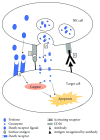Effect of Natural Compounds on NK Cell Activation
- PMID: 30671486
- PMCID: PMC6323526
- DOI: 10.1155/2018/4868417
Effect of Natural Compounds on NK Cell Activation
Abstract
Natural killer (NK) cells are lymphocytes of the innate immune system that survey the body for stressed and abnormal cells. The integration of signals that they receive through various inhibitory and activating cell surface receptors controls their activation and ability to kill target cells and produce cytokines. In this manner, phenotypically and functionally distinct subsets of NK cells help protect against microbial infections and cancer and shape the adaptive immune response. NK cells can use two different mechanisms to kill their targets, either by cytotoxic granule exocytosis or by induction of death receptor-mediated apoptosis. Death ligands belong to the tumor necrosis factor (TNF) family of ligands. Upon release in close proximity to a cell slated for killing, perforin forms pores in the cell membrane of the target cell through which granzymes and associated molecules can enter and induce apoptosis. NK cells are also involved in antibody-dependent cellular toxicity via the CD16 receptor. In addition to target recognition, NK cells can be also activated by treatment with multiple compounds with stimulatory properties. Apart from interleukins, which belong to the best characterized group of NK cell-stimulating compounds, vitamins and constituents extracted from plants also display the ability to activate NK cells. The current review characterizes several groups of NK cell-activating compounds: vitamins belonging to classes A, B, C, D, and E, polysaccharides, lectins, and a number of phytochemicals used in cancer research, exhibiting stimulatory properties when applied to NK cells. Although in most cases the exact mechanism of action is not known, constituents described in this review seem to be promising candidates for NK cell-stimulating drugs.
Figures


Similar articles
-
Receptors and lytic mediators regulating anti-tumor activity by the leukemic killer T cell line TALL-104.J Leukoc Biol. 2005 Aug;78(2):359-71. doi: 10.1189/jlb.0604360. Epub 2005 Jun 3. J Leukoc Biol. 2005. PMID: 15937142
-
Activation of NK cell cytotoxicity.Mol Immunol. 2005 Feb;42(4):501-10. doi: 10.1016/j.molimm.2004.07.034. Mol Immunol. 2005. PMID: 15607806 Review.
-
Cooperation of natural killer cell stimulatory factor/interleukin-12 with other stimuli in the induction of cytokines and cytotoxic cell-associated molecules in human T and NK cells.Cell Immunol. 1994 Jul;156(2):480-92. doi: 10.1006/cimm.1994.1192. Cell Immunol. 1994. PMID: 7912999
-
Cellular mechanisms of lymphocyte-mediated lysis of tumor cells.Ann Ist Super Sanita. 1990;26(3-4):369-84. Ann Ist Super Sanita. 1990. PMID: 2151107 Review.
-
Influence of reverse signaling via membrane TNF-alpha on cytotoxicity of NK92 cells.Eur J Cell Biol. 2009 Mar;88(3):181-91. doi: 10.1016/j.ejcb.2008.09.001. Epub 2008 Oct 23. Eur J Cell Biol. 2009. PMID: 18950896
Cited by
-
Microvascular Inflammation of the Renal Allograft: A Reappraisal of the Underlying Mechanisms.Front Immunol. 2022 Mar 22;13:864730. doi: 10.3389/fimmu.2022.864730. eCollection 2022. Front Immunol. 2022. PMID: 35392097 Free PMC article. Review.
-
Functional Inhibition of Natural Killer Cells in a BALB/c Mouse Model of Liver Fibrosis Induced by Schistosoma japonicum Infection.Front Cell Infect Microbiol. 2020 Nov 19;10:598987. doi: 10.3389/fcimb.2020.598987. eCollection 2020. Front Cell Infect Microbiol. 2020. PMID: 33330140 Free PMC article.
-
Natural killer cells associated with SARS-CoV-2 viral RNA shedding, antibody response and mortality in COVID-19 patients.Exp Hematol Oncol. 2021 Jan 27;10(1):5. doi: 10.1186/s40164-021-00199-1. Exp Hematol Oncol. 2021. PMID: 33504359 Free PMC article.
-
The Next-Generation of Combination Cancer Immunotherapy: Epigenetic Immunomodulators Transmogrify Immune Training to Enhance Immunotherapy.Cancers (Basel). 2021 Jul 18;13(14):3596. doi: 10.3390/cancers13143596. Cancers (Basel). 2021. PMID: 34298809 Free PMC article. Review.
-
Screening and Characteristics Analysis of Polysaccharides from Orah Mandarin (Citrus reticulata cv. Orah).Foods. 2023 Dec 25;13(1):82. doi: 10.3390/foods13010082. Foods. 2023. PMID: 38201110 Free PMC article.
References
Publication types
MeSH terms
Substances
LinkOut - more resources
Full Text Sources

